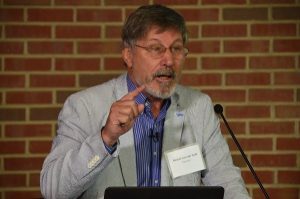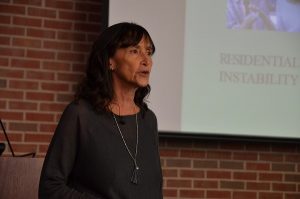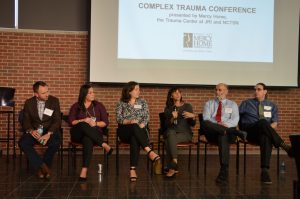Have Mercy! Gala Celebrates Seventeenth Year
This year’s 17th annual Have Mercy! spring gala was another tremendous success, thanks to our Associate Board members and friends...
May 22, 2025
September 27, 2016

Almost 150 professionals and experts in the field of child and family services recently packed into our boys campus dining hall for the “Treating Complex Trauma within Systems of Care” conference. Co-sponsored by Mercy Home, the National Child Traumatic Stress Network (NCTSN) and the Trauma Center at Justice Resource Institute (JRI), the day-long symposium served as an opportunity for child services professionals to exchange ideas, practices, and philosophies on treating young people struggling with complex trauma.
Centered in Boston, The Trauma Center is a leading organization in the treatment of complex trauma, especially among adolescents. It is renowned for the development and implementation of the Attachment, Regulation, and Competency (ARC) framework. In providing our own system of care, Mercy Home uses the ARC framework as the basis for the agency’s treatment of complex trauma. Coworkers have led such an effective implementation of the ARC framework, in fact, that Clinical Director Emily Neal and Learning & Development Director Jeremy Karpen were asked by the Trauma Center to become certified, national trainers of the ARC framework of care.
Fr. Scott kicked off the conference by welcoming and thanking the audience members for their participation, especially those who had traveled from around the country to attend. He shared with them the history of Mercy Home, highlighting the long-lasting connection between Boston and the Agency. From the founding of Mercy Home to the initial source of financial support, the city of Boston has played a key role in the success of the Agency—an impact, Fr. Scott noted, which continues into the present day.
“We always want to have the best practices here at the Home,” he said, “and that led us to the Trauma Center at Boston, and a collaboration that I’m very, very grateful for.” Fr. Scott also explained the various treatment functions of Mercy Home, from the Friends First mentoring program to the AfterCare alumni support program. He cited each component as critical to the “continuum of care” the Home provides our boys and girls.
Next to the podium was Rachel Liebman, Ph.D., Postdoctoral Fellow and Project Coordinator at the Trauma Center. Dr. Liebman provided an overview of the day’s events, which included four speaker sessions focusing on various systems of care inhabited by adolescents, namely, school, family, residential, and community structure. First, however, she introduced the keynote speaker: Dr. Bessel van der Kolk, founder of the Trauma Center.

During his keynote session, “Complex Trauma: Development & Neurobiological Impact,” Dr. van der Kolk outlined many misconceptions regarding complex trauma, from its perceived victims, to its effect on human development, to the nature of treatment. Dr. van der Kolk provided a particularly sobering statistic that underscored the importance of the day’s events: “for every soldier who comes back damaged from war, there’s at least 30 kids right at home who are just as damaged if not more damaged, and they don’t have nearly as much attention [as soldiers].”
Dr. van der Kolk gave listeners a unique and fascinating picture of trauma. “Trauma isn’t a story,” he said. “It’s the imprint of unintegrated sensations. Those sensations are the triggers.”
Trauma damages our basic movement and rhythm. It takes us out of sync with others, disrupting our patterns of communication. This, Dr. van der Kolk asserted, impacts the most important part of healthy human life: relationships. “The security and rhythmicity of our attachment system is more important than specific traumatic events,” he said. It lives in the body, specifically in the functions of the brain stem: abnormal breathing, sleeping and eating. It affects our alarm system, and the map of how we see and interact with the world.
To Dr. van der Kolk, trauma work is “helping people deal with those distressing feelings in their bodies.” He spoke about the value of helping people sync up rhythmically: “When you’re in sync with people, the feeling of joy is inevitable.” We can help people change their damaged maps, and rewire their alarm systems, with “experiences that directly contradict it in visceral ways.” And through imagination work, we can keep people from feeling like victims of where they are.
In addition to defining his field as important humanitarian labor, Dr. van der Kolk believes work with complex trauma is essential economic work: “The cost of child maltreatment is higher than cancer or heart disease.” He also emphasized the importance of innovative treatment, saying the NCTSN gives us a place to communicate what we discover.
“Any treatment that helps people tolerate noticing themselves, seeing inside…that helps people be in tune with others, that helps people imagine new realities, is by definition helpful,” he said.

The conference then moved to the first set of concurrent breakout sessions, discussing family and school systems. Laurel Kiser, Ph.D., University of Maryland, led the “Families Track” session, “Poverty and Traumatic Stress: Strategies for Building Family Resilience.” Kiser advocated the importance of understanding trauma within the context of poverty and societal structure.
To Kiser, the nature of society’s relationship with low-income households is one marked by paradox: “Clearly there’s a poverty industry that kind of supports people in poverty and [also] puts up lots of barriers for people living in poverty.” This financial instability is one of the key causes of stress and trauma in low-income households.
Kiser also emphasized racial and systemic discrimination as inexorably linked to poverty and causes of trauma. “The impact of being separate and unequal can be…traumatic,” she said, a point that was tragically punctuated by the shooting deaths of two black men by police this week. In order to effectively treat complex trauma, subjects of social justice and discrimination must be part of the discussion, said Kiser.
The cyclical nature of poverty and institutional racial discrimination has led to families experiencing similar stress and trauma across multiple generations. The adaptations to these high-stress, high-trauma environments are reinforced as they are passed down to newer generations, said Kiser. In order to effectively treat individuals suffering from complex trauma, “I think it’s really important to consider,” she said, “how that trauma might impact [children and their families’] ability to function in current situations.”

The “Schools Track” breakout session, “Moving From Complex Trauma to Resilience in Schools” was led by Chris Blodgett, Ph.D., of Washington State University. Blodgett addressed the value of bringing principles of the ARC model into school settings, ways to find common ground with educators, implementable trauma informed strategies that buy back instructional time, and the key features of training that help lasting change take hold.
We don’t know about the majority of violence that happens to kids, Blodgett explained. Of what we do know, 74% is revealed to educators. “Why work with schools?” he asked. “Schools know.”
Teachers know how to handle competency, the “C” in the ARC framework, but often can’t get there without the “A” and the “R.” Blodgett has found ACEs, adverse childhood experiences, to be the best way into the conversation. He helps teachers understand that those experiences can lead to adaptive issues that are, at heart, safety seeking and need fulfillment. Understanding them as, “This is the best I could do in the circumstances I was in,” helps to normalize them.
Blodgett also spoke about achieving his major objectives in schools—physical safety, emotional safety, predictability, and consistency—not only in individual classrooms, but at the level of policy and procedure, especially related to punitive practices that drive students out of school. “Punishment teaches nothing,” he continued: “It only suppresses behavior.” Reframing how schools understand disregulated behavior is critical to disrupting the “school-to-prison pipeline” that is heavily connected to race and poverty.
In the afternoon, the “Community Track” session, “Developmental Trauma and Youth Violence” was led by Brad Stolbach, Ph.D., University of Chicago.
For Stolbach, there are many misguided philosophies in the treatment of trauma, the most prominent of which is the understanding of the nature of trauma. “If you have one [type of trauma,” he said, “you’re likely to have more than one. [But] they’re instead treated as individual phenomena.” The diagnosis of trauma itself, he continued, is often defined by the outcome of the trauma, rather than the cause. Without proper diagnosis, it can be difficult, if not impossible, to effectively treat complex trauma.
Stolbach also emphasized the importance of the attachment behavioral system, touched on in the keynote address by Dr. van der Kolk. This rhythm and synchronization between mother and child is “how a baby gets a coherent sense of self,” he said.
Language, according to Stolbach, plays a key role in the process of attachment identity development. “A very important way that we regulate ourselves,” he said, “is communicating what’s going on inside us to another person.” When relationships and attachment behavior are disrupted, adolescents are unable to develop key developmental capacities—the most important of which is regulating internal emotions.
Mercy Home coworkers Jeremy Karpen, LCPC, Emily Neal, LCSW, and Kat Cahill, LCPC, led the “Residential Track” afternoon session, “Refining the Mercy Model: Implementing the Attachment, Regulation, Competency (ARC) Framework in Residential Care.”
Neal and Karpen introduced listeners to Mercy Home’s programs, staff structure, and the evolution of our treatment approach. They gave an overview of the components of the ARC framework, which is at the heart of our “Mercy Model” today.
They took the group through Mercy Home’s process of implementing ARC: from reading groups, ambassador visits, and agency-wide training to clinical calls, outcomes and testing, and systems calls. They also shared specific effective response and attunement training activities other practitioners can try with their coworkers.
Kat Cahill, Therapist in Mahoney Home, gave a case example, demonstrating the ways ARC strategies have helped a particular youth grow at Mercy Home. And she detailed effective ARC-related activities, strategies and priorities of the Mahoney Home milieu. The three then answered questions from participants in the audience at different stages of adopting or learning about the ARC model about specific issues that have come up at their own agencies.

In the closing ceremony, the day’s presenters, representing school, residential, community and family settings, shared their takeaways. Brad Stolbach, Ph.D., University of Chicago, stressed the importance of understanding history and structure when it comes to those we serve, a theme common to all of the day’s sessions: “We have to stop judging right vs. wrong behavior, and start understanding the context in which the behavior makes sense.”
Mercy Home coworker Emily Neal was inspired by the possibilities for sharing and support across agencies. “There’s such a great community in this room dedicated to these brave and inspiring kids,” she said.
Coworker Jeremy Karpen invited the listeners to think about how they can make a difference not just through intervention, but on the level of prevention. “I charge you all,” he said: “How can you be change agents?” He encouraged them to make their voices heard, to run for office, and to see young people as change agents as well. “[Make] sure we aren’t hiding any of this knowledge from them,” he said. “I want our kids to see themselves in the assembly, and I want to see our kids up here.
Our sincere thanks to the Trauma Center and NCTSN for their work in sponsoring this event; to conference speakers for sharing their time and expertise with like-minded professionals in their field; to all of our guests who took part in this important dialogue; and to all of our coworkers who ensured the success of this momentous discussion.
This year’s 17th annual Have Mercy! spring gala was another tremendous success, thanks to our Associate Board members and friends...
May 22, 2025
Mercy Home launched its month-long March for Kids celebration on March 1 when our Associate Board, a volunteer group of young professionals...
March 12, 2025
Our friends went all in for Mercy Home at our annual Poker Night fundraiser this January 30th. A record 275...
February 13, 2025
Comments